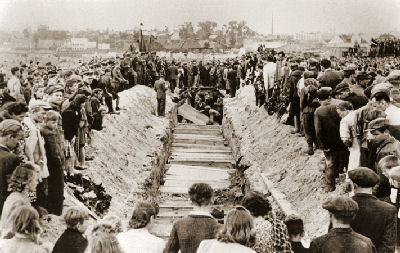
Dziś kolejna rocznica pogromu kieleckiego.
Jest regułą, że gdy temat tej zbrodni pojawia się na forach i w grupach internetowych, część dyskutantów zwraca uwagę na to, że pogrom mógł być rezultatem komunistycznej prowokacji (za tą prowokacją miało stać UB lub NKWD).
Chciałbym – nie wnikając w szczegóły tych hipotez i nie podejmując z nimi polemiki, wręcz przeciwnie: przyznając, że są wysoce prawdopodobne – podkreślić rzecz, którą uważam za najważniejszą w tej całej sprawie.
Żadna prowokacja nie ma szans na powodzenie, gdy nie trafia na podatny grunt. Żadna prowokacja nie działa, gdy nie napotyka pozytywnego odzewu ze strony tych, których zamierza sprowokować. Prowokowanie mieszkańców Kielc do mordowania Żydów nie spowodowałoby śmierci ani jednego człowieka, gdyby mieszkańcy Kielc 4 lipca 1946 roku nie chcieli Żydów mordować, gdyby nie mieli w sobie już gotowej nienawiści do ludzi, których przecież nie znali, o których nie wiedzieli niczego poza jednym: że są Żydami.
I gdyby fakt, że ci ludzie to Żydzi, nie był dla nich wystarczającym uzasadnieniem, aby ich atakować i odbierać im życie.
Wiem: to są sprawy oczywiste, ale trzeba je przypominać, ponieważ hipotezy o prowokacji jako przyczynie pogromu kieleckiego funkcjonują często nie tylko jako próby wyjaśnienia tamtej zbrodni, ale także jej – co najmniej częściowego – usprawiedliwienia.
Paweł Jędrzejewski

Pogrom kielecki, to była czysta robota żydowskiego UB, wypuscić głupich Polaczków niech zamordują paru Żydów a reszta będzie zwiewać do Palestyny….
PolubieniePolubione przez 1 osoba
Nie dziwie sie tego bazgrania of ciebie, jak zwykle Polacy zwalniają wszystko na Żydów nawet że się sami zamordowali?? Czy jesteś normalny? Ja nie myślę.
PolubieniePolubienie
Chciałbym wierzyć że pogrom kielecki to przejaw głupoty i ciemnoty, ale obawiam się że jak za każdą prowokacją tak i za tą stał ktoś, gdzieś w bezpiecznym pokoju i na wygodnym fotelu. Ktoś, kto zaplanował, puścił mocną plotkę i ona chwyciła. Padła na podatny grunt i ,… dalej potoczyło się jak zwykle. Ciemnota wykonała resztę. Szkoda tylko tych którzy zginęli, ale to mogło być wkalkulowane ofiary i ryzyko.
PolubieniePolubione przez 1 osoba
“To provoke the inhabitants of Kielce to murder Jews would not result in the death of a single man if the inhabitants of Kielce did not want to murder Jews on July 4, 1946, if they did not already have ready hatred towards people they did not know, about which they knew nothing but one: they are Jews.”
You are wrong. I suggest you read the history rather than accuse Poles of wanting to murder Polish Jews because they were Polish Jews.
“It is a rule that when the subject of this crime appears in forums and on Internet groups, some discussants point out that the pogrom could have been the result of a communist provocation (UB or NKVD was supposed to stand behind this provocation).”
To the contrary, the available empirical evidence strongly indicates Kielce was not only Soviet-staged but also was intended to defame Poland.
Between June and July, 1946, the last transports full of Jewish repatriates reached Poland from the USSR, in total about a quarter million people. Among them, about 150,000 left soon afterwards as a direct result of the pogroms organized by the NKVD, as well as due to the influences of Zionist organizations, which were counting on increasing the Jewish population of Palestine, albeit for a completely different reason than the USSR. Because Jews would not ordinarily set out for the unknown, factors which would incline them to want to emigrate were necessary. For this there was nothing better than pogroms: for a nation which had only recently lifted its head from the wartime execution block, oftentimes having lost entire families and communities, the threat of death was reason enough to want to flee, leaving everything behind and beginning life anew. According to the NKVD, in later years it was the Zionists themselves who provoked and carried out pogroms in the years 1950-1951, in order to force 547,000 Jews to emigrate to Israel from Arab countries like Morocco, Algeria, Tunisia, Libya, Egypt, Saudi Arabia, Jordan, Syria, and Lebanon as well as other Islamic Republics, like Iran, Pakistan, Turkey, and Ethiopia. What isn’t often mentioned is that earlier outbursts of violence similar to the Kielce pogrom took place in other European countries under Soviet control. Pogroms occurred in Slovakia, in Hungary, and in Ukraine—always according to a very similar scenario. Likewise, the reasons for organizing the other pogroms were identical to those in Poland: they drew the world’s attention away from Soviet atrocities. Professor Jerzy Robert Nowak writes, “In a historical monograph on the history of Jews in the Warsaw Pact countries, written by a group of distinguished Jewish researchers, significant attention is paid to the role of the communist “apparatuses of order:” the military and the police. In a period of time marked by violent anti-semitic outbursts in the city of Velke Topolcany, around September 24, 1945, over the course of six hours of violence and disorder, all of the Jewish houses of the city were destroyed and 49 people were injured. During this whole time, the police not only didn’t intervene in order to protect the assaulted Jews, they actively participated in the pogrom along with the military.” (The Jews in the Soviet Satellites, Peter Meyer, Bernard D. Weinryb, et al. Westpoint: Connecticut. 1953. 105). Further, “On March 15, 1991, in the columns of the popular Hungarian daily newspaper, Magyar Nemzet, the assessments of the outspoken Hungarian historian Maria Schmidt were published. She concluded that it was the Soviet secret services who were behind the mass hysteria surrounding ritual murders, propagated in Slovakia in April, 1946, in Hungary in May, 1946, and in Poland in June, 1946. According to Maria Schmidt, “The Soviet authorities wanted to free themselves from Jewish religious and bourgeois groups in their ranks, who the authorities considered to be hotbeds of capitalism. The authorities wanted to augment the troubles of Western powers by compelling them to accept Jewish refugees; in particular they wanted to frustrate Great Britain, which was, at the time, controlling Palestine through a League of Nations mandate. Finally, by ascribing the pogroms to the manipulations of a reactionary underground, they wanted to strengthen communist groups and collectives in the East and in the West, comprised of members of the Communist party as well as of sympathizers of Jewish descent.” (Janos Pelle, “A kunmadarasi pogrom. Shylock Hunniban II,” in Magyar Nemzet. March 15, 1991).
Also, Michael Chęcinski, in his book Poland: Communism-Nationalism-Anti-semitism, wrote about the role played by Mihail Aleksandrowicz Dyomin, a top Soviet intelligence officer. Chęcinski, a Polish Jew and former officer of the Polish Army who was linked with the Communist Secret Police, wrote that Dyomin specialized in Jewish matters and traveled to Poland at that time. According to Chęciński, Dyomin came to the Kielce area shortly before the pogrom and left soon afterwards. The boy’s kidnapping was faked, with a group of men threatening him with a beating if he did not claim that he had been kidnapped by Jews. Significantly, the boy was the son of a Communist informer. Later, Dyomin himself interrogated the boy. During the Kielce pogrom, the Communist militia disarmed the Jews and shot many of them in cold blood. Significantly, neither the father of the “kidnapped” boy nor members of the Communist militia ever faced trial. Former US Ambassador to Poland Arthur Bliss Lane was chosen to report on the incident and did so in his book „I Saw Poland Betrayed: An American Ambassador Reports to The American People”. Lane stated that “But almost all sources agreed that the [Communist] militia had been responsible to a great extent for the massacre, not only in failing to keep order but in the actual killing of the victims, for many had been shot or bayoneted to death…” It should be noted that the Communist militia in postwar Poland was fully controlled by the Soviet occupiers. In his book, „The Rape of Poland: Pattern of Soviet Aggression”, statesman Stanislaw Mikolajczyk writes that Communist militia officer Major Sobczynski ordered foundry workers to gather at a certain time in the market place for a meeting. Mikolajczyk writes: “His plan was to point to a Jewish boarding house that fronted on the market place and to have them shout that Polish children were being killed there. Major Sobczynski hoped to produce a rush on the building, in which case the army would open fire on the crowd. This would add to the terror of the times. But the Communists had forgotten to remove the telephone from the boardinghouse. A rabbi, informed that a mob was being provoked to attack the place, phoned the local army headquarters to appeal for protection. Army troops soon arrived under the command of a Russian colonel. The colonel–who was, of course, familiar with the entire plot–was surprised to see the crowd on which his men were scheduled to fire had not as yet gathered. He had to change his plans. Lacking all pity, he sent his men against the boardinghouse, killing forty-one of its Jewish occupants and wounding forty others. In the hope of arousing the impending crowd to an overt act against the army he ordered the dead thrown into the streets. Any movement of the crowd would have been his cue to shoot into the gathering. The foundry workers, however, crossed everybody up by escaping while en route to the scene of their intended slaughter.”
PolubieniePolubienie
What a lot id crap!! Blaming Jews for murdering they own people??? You are sick in the head, get some help.
PolubieniePolubienie
Nie dziwie sie tego bazgrania of ciebie, jak zwykle Polacy zwalniają wszystko na Żydów nawet że się sami zamordowali?? Czy jesteś normalny? Ja nie myślę.
PolubieniePolubione przez 1 osoba
nie wstyd tak wrabiać Polaków w mordercze chęci? to jeszcze gorsze a przy tym spora obelga dla całego Narodu.
naturalnie, w przypadku gdy zabijają Żydzi, nie wolno napisać, że najwidoczniej Żydzi „chcieli mordować i mieli w sobie gotową nienawiść, która się nazbierała, bo to przecież taki zły naród”. co innego tak napisać o Polaczkach i jeszcze udawać, że to łaskawe i dobroduszne wytłumaczenie, pewnie głosy z nieba powiedziały.
czy na pewno chodziło o antysemityzm, czyli to, że byli Żydami? ludzie są w stanie bić się z obcymi im z najróżniejszych powodów i tak właśnie często bywało w czasach zdziczenia i nowej okupacji, gdy jeszcze strzelano i pacyfikowano wioski, nieraz z podobną liczbą ofiar. któż by to jednak wspominał, skoro pogrom ważniejszy, bo chodzi o Żydów i zaczęli wyjeżdżać.
dziś żołnierze izraelscy są w stanie strzelać do nieuzbrojonych więc nie dziwmy się obłudnie, że po największej, niewiarygodnie zbrodniczej wojnie mogło dochodzić do ekscesów kończących się śmiercią. w takim przypadku prowokacje mają swoją sporą wagę, zresztą nie chodzi przecież o sprowokowanie tłumu tylko prowokację w postaci całego zajścia, kontrolowanego przez siły komunistyczne, bo to one decydowały o tym, jak sytuacja się rozwinie. to przecież komunistyczni żołnierze zaczęli a jeszcze dokładniej- komunistyczni oficerowie, UB mimo wiedzy i próśb nie zechciało reagować. mimo to zwala się pogrom na Polaków, obciążając tym cały naród i dowodząc tym antysemityzmu milionów ludzi. To obrzydliwe, że i dziś jakiś komuch może śmiać się zza grobu, jak to na dekady udało się wrobić i skłócić
PolubieniePolubienie
Nie chodzi o to czy to bylo Ub czy nie, chodzi o to , jak malo bylo potrzeba, aby tlum zaczol te niedobitki z Oswiecimia mordowac.
To pokazuje narod.
Niektorym sie nie podoba.
PolubieniePolubienie